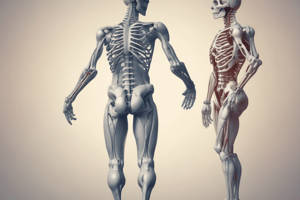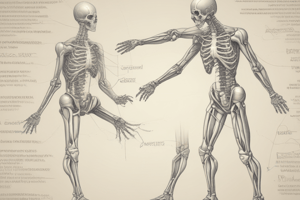Podcast
Questions and Answers
What is the primary difference between open and closed fractures?
What is the primary difference between open and closed fractures?
- Open fractures are more severe than closed fractures
- Open fractures involve a shift in bone alignment, while closed fractures do not
- Open fractures involve a break in the skin, while closed fractures do not (correct)
- Open fractures are more common in the elderly, while closed fractures are more common in young adults
What is the primary goal of reduction in fracture management?
What is the primary goal of reduction in fracture management?
- To restore range of motion and strength to the affected area
- To immobilize the fracture using casts or splints
- To remove bone fragments from the affected area
- To realign bone fragments manually or surgically (correct)
What is the term for a fracture that involves multiple bone fragments?
What is the term for a fracture that involves multiple bone fragments?
- Hairline fracture
- Comminuted fracture (correct)
- Noncomminuted fracture
- Displaced fracture
What is the primary cause of osteoarthritis?
What is the primary cause of osteoarthritis?
What is the term for inflammation of tendons?
What is the term for inflammation of tendons?
What is a risk factor for musculoskeletal disorders?
What is a risk factor for musculoskeletal disorders?
What is the primary goal of physical therapy in the treatment of musculoskeletal disorders?
What is the primary goal of physical therapy in the treatment of musculoskeletal disorders?
What type of fixation involves the use of plates, screws, or rods to stabilize the fracture from within the body?
What type of fixation involves the use of plates, screws, or rods to stabilize the fracture from within the body?
What is the term for compression of the median nerve, leading to hand and wrist symptoms?
What is the term for compression of the median nerve, leading to hand and wrist symptoms?
What is the term for a fracture that involves a small crack in the bone?
What is the term for a fracture that involves a small crack in the bone?
Flashcards are hidden until you start studying
Study Notes
Fracture Management
Classification of Fractures
- Open/Closed: Open fractures involve a break in the skin, while closed fractures do not
- Displaced/Nondisplaced: Displaced fractures involve a shift in bone alignment, while nondisplaced fractures do not
- Comminuted/Noncomminuted: Comminuted fractures involve multiple bone fragments, while noncomminuted fractures do not
- Hairline/Complete: Hairline fractures involve a small crack in the bone, while complete fractures involve a complete break
Principles of Fracture Management
- Reduction: Manual or surgical realignment of bone fragments
- Immobilization: Use of casts, splints, or other devices to stabilize the fracture
- Rehabilitation: Restoring range of motion, strength, and function to the affected area
Types of Fracture Fixation
- Internal fixation: Use of plates, screws, or rods to stabilize the fracture from within the body
- External fixation: Use of external devices to stabilize the fracture from outside the body
- Percutaneous fixation: Use of pins or wires to stabilize the fracture through small incisions
Musculoskeletal Disorders
Common Musculoskeletal Disorders
- Osteoarthritis: Wear and tear on joints, leading to pain and stiffness
- Rheumatoid Arthritis: Autoimmune disorder causing inflammation and joint damage
- Tendinitis: Inflammation of tendons, leading to pain and stiffness
- Carpal Tunnel Syndrome: Compression of the median nerve, leading to hand and wrist symptoms
Risk Factors for Musculoskeletal Disorders
- Age: Increased risk with age
- Obesity: Increased risk due to excessive weight and strain on joints
- Occupation: Certain jobs or activities that involve repetitive strain or heavy lifting
- Genetics: Family history and genetic predisposition to certain disorders
Treatment Options for Musculoskeletal Disorders
- Medications: Pain relievers, anti-inflammatory drugs, and disease-modifying anti-rheumatic drugs (DMARDs)
- Physical Therapy: Exercises and stretches to improve range of motion, strength, and function
- Surgery: Joint replacement, osteotomy, and other surgical interventions
- Lifestyle modifications: Weight loss, exercise, and ergonomic changes to reduce strain on joints
Studying That Suits You
Use AI to generate personalized quizzes and flashcards to suit your learning preferences.




